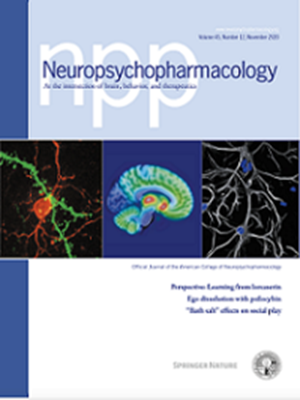The mesolimbic reward pathway is necessary for disruptions in cocaine-seeking behavior following mediated devaluation
IF 6.6
1区 医学
Q1 NEUROSCIENCES
引用次数: 0
Abstract
We developed an approach to disrupt cocaine-seeking behaviors using mediated devaluation. Male rats underwent cocaine self-administration training in which active lever responses led to cocaine infusions and the presentation of a tone-light conditioned stimulus (CS). Subsequently, during mediated devaluation rats received non-contingent presentations of the cocaine-associated CS in a second distinct context, which led to the cue-evoked retrieval of associated memories. This was immediately followed by an intraperitoneal injection of lithium chloride (LiCl) and served to pair the memory of cocaine reward with gastric malaise. Consequently, this led to a substantial reduction in cocaine-seeking behavior during extinction training, relative to rats that received CS-saline or LiCl alone during mediated devaluation. Cue- and cocaine-evoked reinstatement testing indicated that the manipulations did not devalue the CS or the reinforcing properties of cocaine. A separate cohort of rats received a dual-viral chemogenetic strategy that permitted circuit-specific inactivation of midbrain ventral tegmental area (VTA) cells projecting to the nucleus accumbens (NAc). Inactivation of VTA→NAc circuitry during mediated devaluation prevented the subsequent reduction of cocaine-seeking behavior during extinction training. Overall, these findings suggest that intact mesolimbic signaling is required to enable disruptions in cocaine-seeking behavior following mediated devaluation.

中边缘奖赏通路是介导性贬值后可卡因寻求行为中断所必需的。
我们开发了一种通过介导贬值来破坏可卡因寻求行为的方法。雄性大鼠接受可卡因自我给药训练,其中主动杠杆反应导致可卡因输注和单光条件刺激(CS)的呈现。随后,在介导贬值期间,大鼠在第二种不同的环境中接受了与可卡因相关的非偶然的神经递质呈现,这导致线索诱发的相关记忆检索。随后立即腹腔注射氯化锂(LiCl),并将可卡因奖励的记忆与胃部不适配对。因此,与在介导的贬值过程中单独接受CS-saline或LiCl的大鼠相比,这导致了灭绝训练期间可卡因寻求行为的大幅减少。提示和可卡因诱发的恢复测试表明,这些操作并没有降低CS或可卡因的强化特性。另一组大鼠接受了双病毒化学发生策略,该策略允许中脑腹侧被盖区(VTA)细胞投射到伏隔核(NAc)的电路特异性失活。在介导的贬值过程中,VTA→NAc回路的失活阻止了戒毒训练中可卡因寻求行为的后续减少。总的来说,这些发现表明,在介导的贬值后,需要完整的中脑边缘信号才能使可卡因寻求行为中断。
本文章由计算机程序翻译,如有差异,请以英文原文为准。
求助全文
约1分钟内获得全文
求助全文
来源期刊

Neuropsychopharmacology
医学-精神病学
CiteScore
15.00
自引率
2.60%
发文量
240
审稿时长
2 months
期刊介绍:
Neuropsychopharmacology is a reputable international scientific journal that serves as the official publication of the American College of Neuropsychopharmacology (ACNP). The journal's primary focus is on research that enhances our knowledge of the brain and behavior, with a particular emphasis on the molecular, cellular, physiological, and psychological aspects of substances that affect the central nervous system (CNS). It also aims to identify new molecular targets for the development of future drugs.
The journal prioritizes original research reports, but it also welcomes mini-reviews and perspectives, which are often solicited by the editorial office. These types of articles provide valuable insights and syntheses of current research trends and future directions in the field of neuroscience and pharmacology.
 求助内容:
求助内容: 应助结果提醒方式:
应助结果提醒方式:


